_We may earn revenue from the products available on this page and participate in affiliate programs. Learn more ›
_
Best for Men
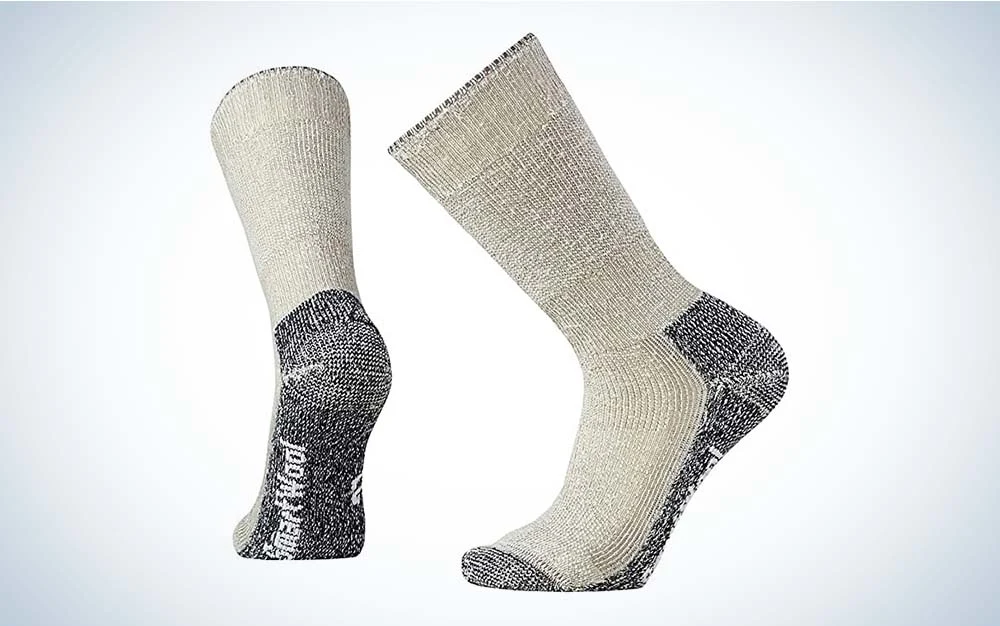
Smartwool Men’s Mountaineering Crew Socks
LEARN MORE
Summary
Super thick, warm wool socks that also provide an exceptional fit for extended warmth.
Best Wool
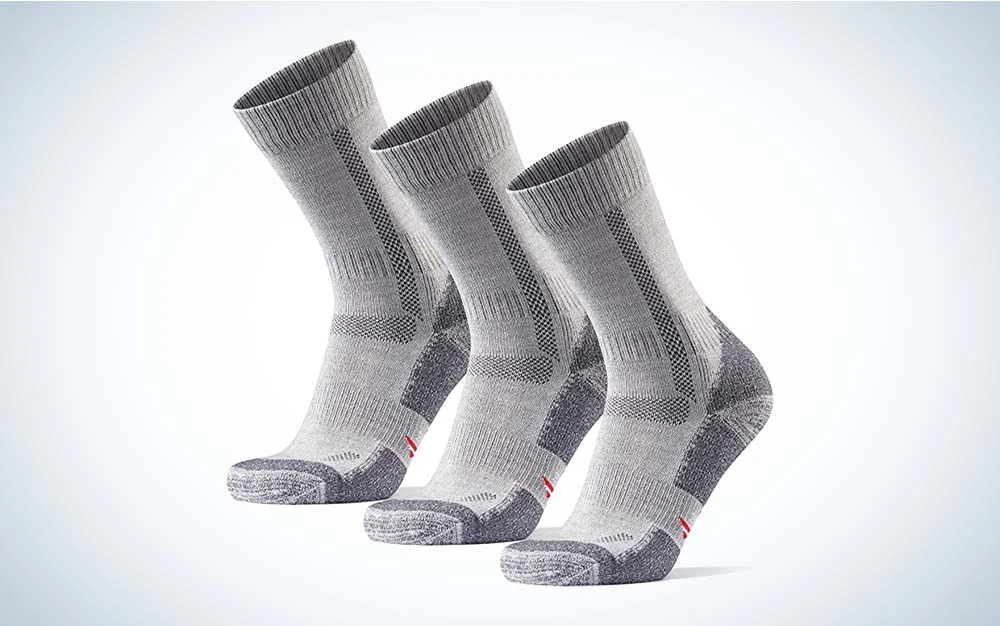
Danish Endurance Merino Wool Cushioned Hiking Socks
LEARN MORE
Summary
Soft, warm, and moisture wicking (like Merino should be) along with cushioning and tailoring to keep extended hikes pain-free.
Best for Women

Smartwool Women’s Classic Crew Socks
LEARN MORE
Summary
With a heavy cushion for warmth, durability, and comfort, these socks have a snug fit without being too tight.
Prevention is key when it comes to cold feet, and quality warm socks are not optional when you plan to be outdoors for extended periods in colder weather. Your activity, climate, and footwear all affect your ideal pair of socks, but a few factors are consistent: material, fit, and sweat-wicking. And as for the factors that vary? We’ve done all the research for you.
Whether you’re hiking socks or lounging at the cabin, we’ve tested and reviewed the best warm socks, from merino wool to thermal options.
Best Overall: Duckworth Midweight Hiking Crew Socks
Best for Hunting: Darn Tough Hunting Boot Socks
Best for Men: Smartwool Men’s Mountaineering Crew Socks
Best for Women: Smartwool Women’s Hike Classic Edition Full Cushion Solid Crew Socks
Best Wool: Danish Endurance Merino Wool Socks
Best for Hiking: Swiftwick Pursuit
Best Cabin: Tibetan Socks Hand-Knit Wool Fleece-Lined Long Slipper Socks
Best Budget: Columbia Medium Weight Thermal
How We Picked the Best Warm Socks
Warm socks are best tested in the cold. The exact style and thickness of the best sock for your feet may differ from what we have recommended below, but luckily, all these brands offer a range of sock options that are sure to suit any outdoor adventure. While I only tested some of these socks on a few trips, others have been staples in my hiking wardrobe for years. Regardless, there were a few important aspects I looked at when choosing the best warm socks for this list:
Comfort: Do the socks fit the activity described? Are they comfortable to wear in hiking boots
, or are they better for more casual wear? Does the fabric rub or create hot spots easily?
Thickness and Warmth: How thick is the sock material? Is it thin yet insulating? Are the socks meant for cold-weather activities or more comfortable for stationary activities?
Fit: How does the sock fit your feet? Does the top of the sock slide down or constrict? Do the socks fit too tight or too loose? Are the sizes described accurate?
Fabric: What type of materials are used? Is the fabric durable? How long does it last under heavy use? What are the care instructions? Can you return or repair the socks under warranty?
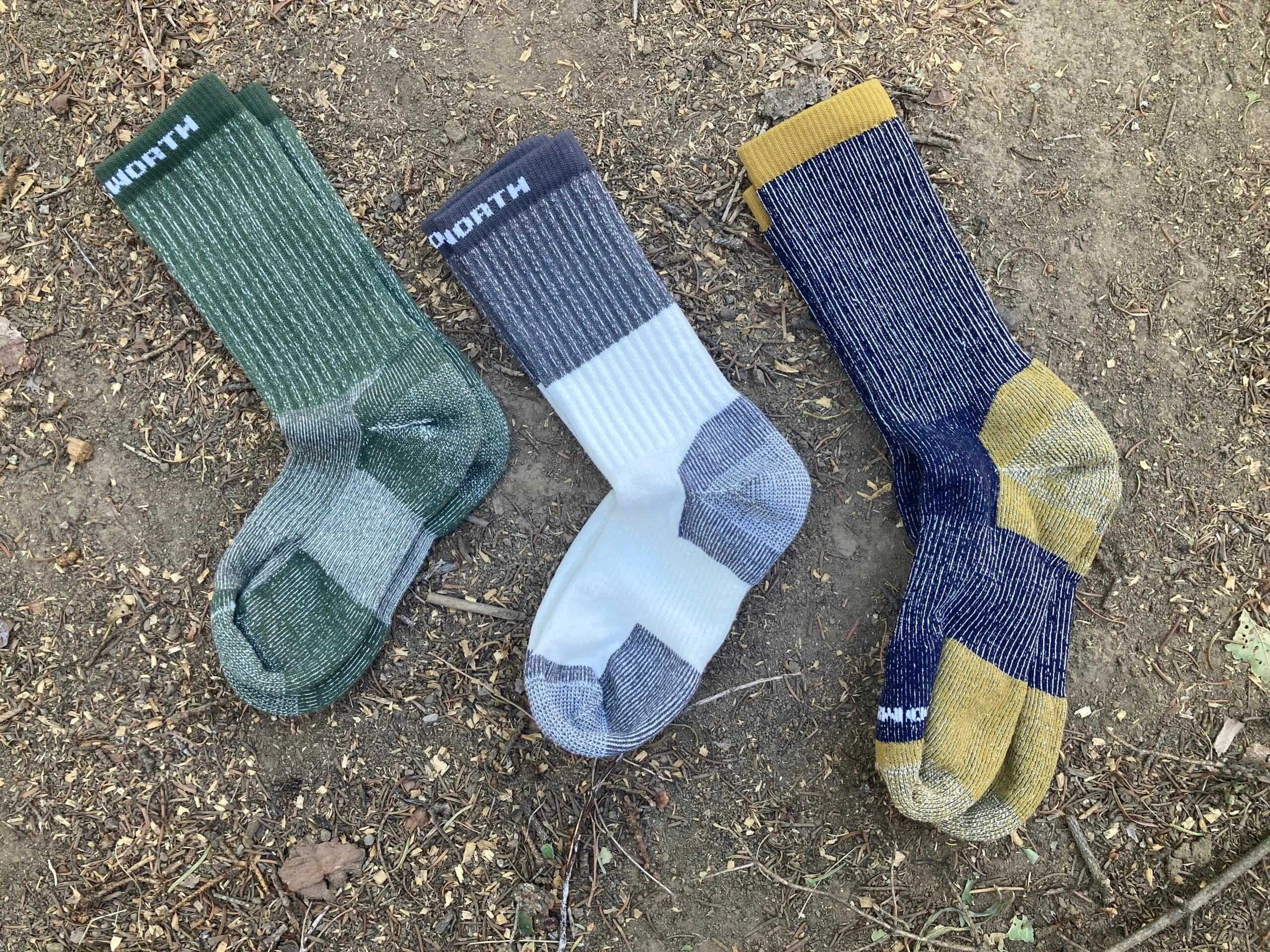
We tested pairs from some of the most popular sock brands to find the warmest. Meg Carney
We also considered company-specific research, verified customer testimonials, company sustainability, and personal experience. Note: Sock recommendations and descriptions are subject to change as more testing is conducted.
Best Warm Socks: Reviews and Recommendations
Best Overall: Duckworth Midweight Hiking Crew Socks
Best Overall

Specs
Length: Crew
Materials: 67% Montana Merino Wool, 24% Nylon, 6% Elastic, 3% Lycra
Thickness: Midweight
Pros
Made in the USA
Itch free wool
Versatile materials and thickness
Top foot fabric ventilation
Snug, athletic fit minimizes movement of fabric
Cons
The top of the sock may be too tight for some people’s calves
Limited warranty offerings
Duckworth is a brand you’re sure to love for their socks and all of their wool offerings. Their products are produced in Montana, and their supply chain information is easily accessible on their website. They offer a wide selection of socks, and among our favorites are the Hiking Crew Socks. These midweight socks are ideal for year-round outdoor adventures. They’re warm enough to be used all winter for snowshoeing, shoveling the driveway, or even winter camping. While I don’t think they’d be the best for extremely cold weather, the versatility is desirable for most average users.
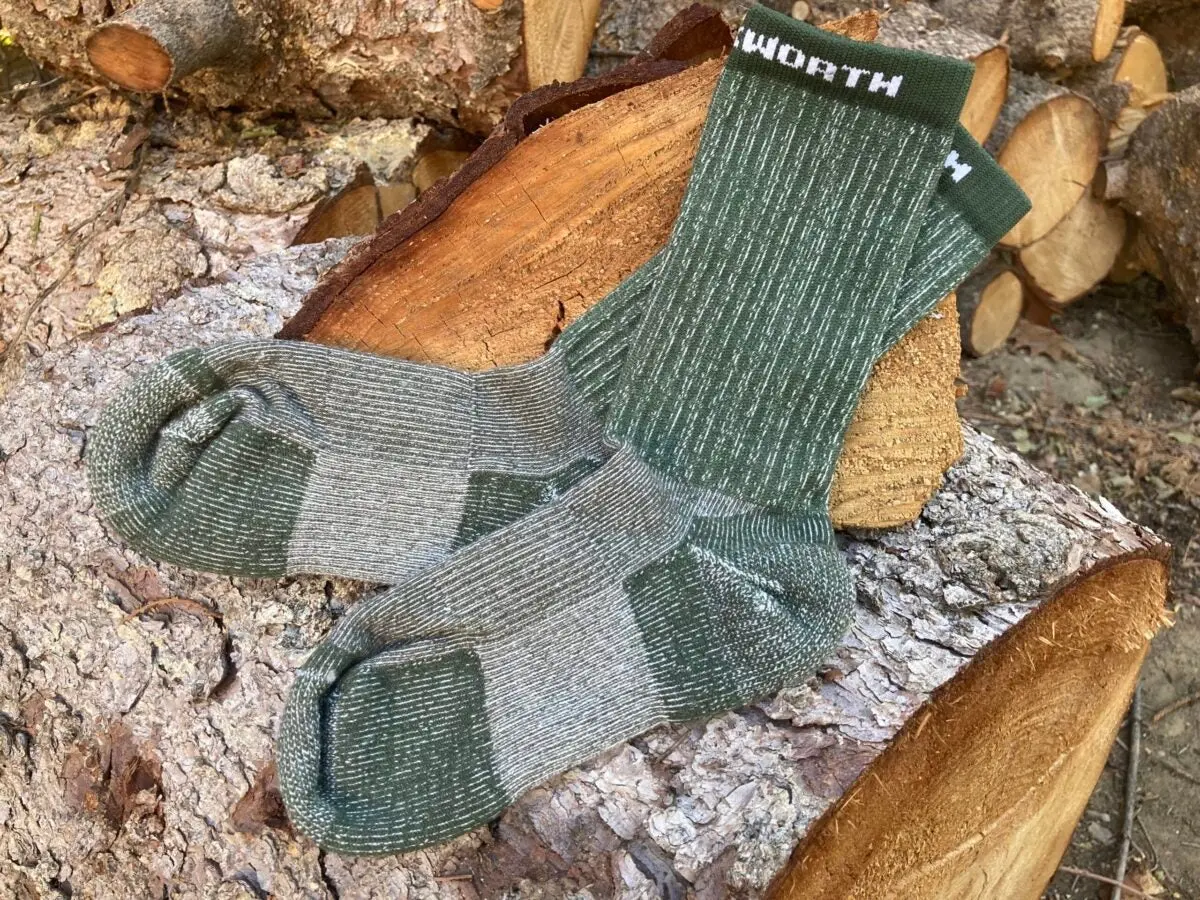
I like that I can wear these Duckworth socks all year long. Meg Carney
The socks themselves I’ve found to be very comfortable and form-fitting. Some wearers may notice they are a bit tight on the calves, so we recommend trying them on first if you have the chance. Duckworth does accept returns, so if you get the sizing off, exchange them within 30 days of purchase if they don’t fit properly. I prefer a thinner sock while hiking, but these midweight socks did just fine on short and long hiking trips. The snug fit prevented hot spots from forming, and the vented material on the top of the foot helped control a release of heat when it did warm up in the middle of the day.
Best for Hunting: Darn Tough Hunting Boot Socks
Best for Hunting
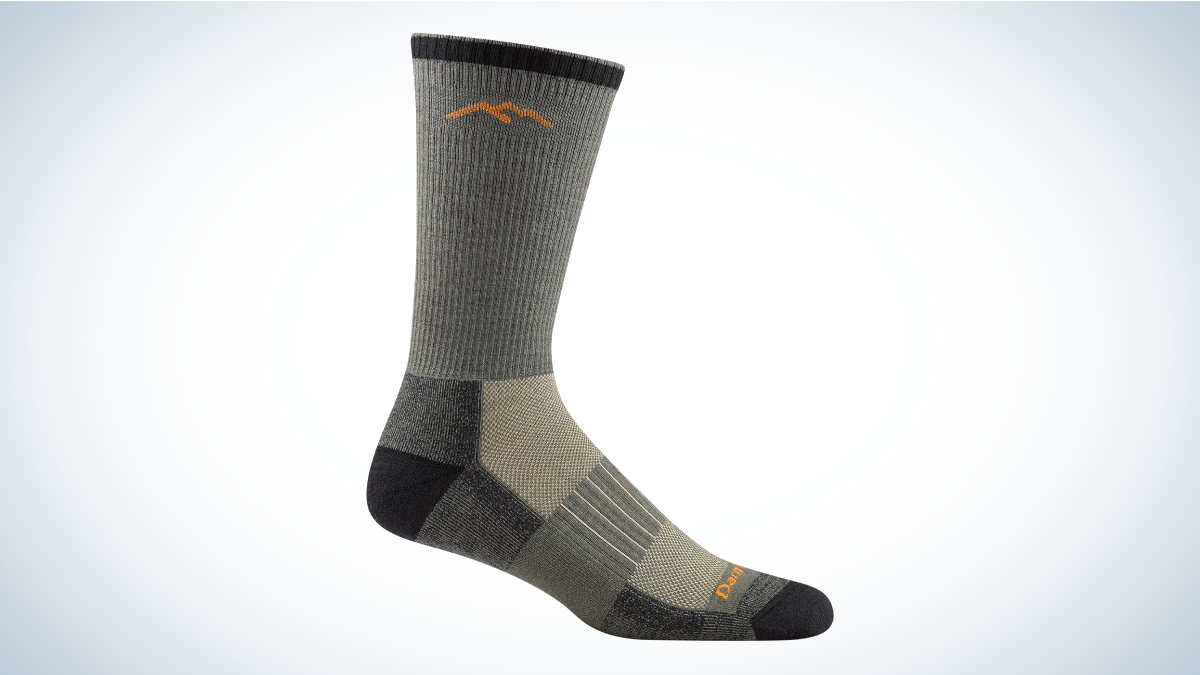
Specs
Length: Crew
Materials: 79% Merino Wool, 19% Nylon, 2% Lycra Spandex
Thickness: Heavyweight
Pros
Highly durable
Lifetime warranty
Full cushion for insulating comfort
Ideal heat regulation even while hiking
Socks stay in place when fitted properly
Cons
Might be tight on the calves for some wearers
Expensive
Darn Tough socks are the best of the best in terms of durability. Don’t let the price make you click away to another brand! Darn Tough is the price they are because of their lifetime guarantee. They’re built to last as long as you do; if they don’t, they’ll replace them. While all Darn Tough socks have their place, we felt the hunting-specific design was perfect for this kind of review.
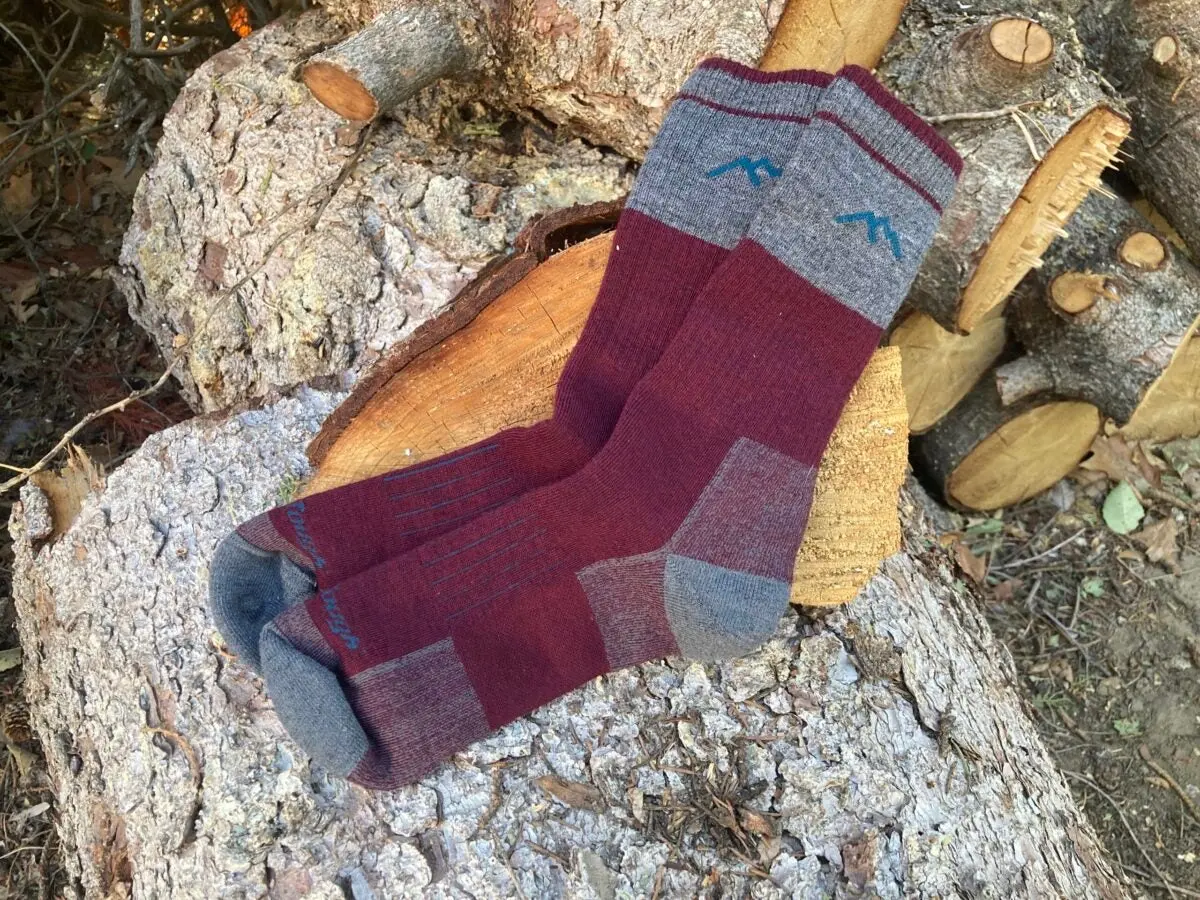
Darn Tough makes some of the warmest and comfiest socks I’ve tried. Meg Carney
The snug fit and full cushion of the sock add optimal comfort in hunting boots, whether trudging through snow or sitting in a tree stand. The top of the crew sock might be tight around the calves, so ensure sizing works for you. I’ve never had an issue with the sizing or the socks fitting too tightly on my calves, but other customers have mentioned this as an issue for them. The new women’s sizing and breathability vents make these socks even better. The crew length works well for most people, but they also come in other thicknesses, lengths, and both men’s and women’s designs.
Best for Hiking: Swiftwick Pursuit
Best for Hiking
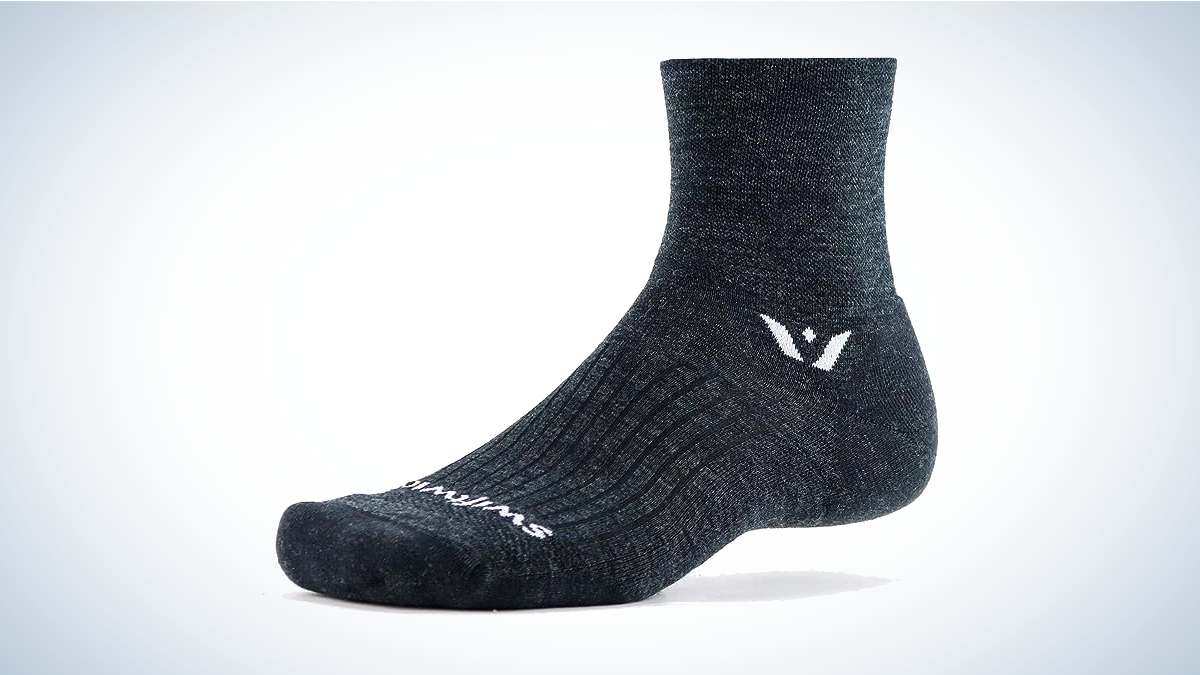
Specs
Length: Crew
Materials: 63% Merino wool / 35% Nylon / 2% Spandex
Thickness: Midweight
Pros
Good price for the level of durability
Pursuit socks are available in several lengths
Regulates temperature and moisture well
Comfortable fit for hiking
Cons
The top of the sock on the 7in length doesn’t always stay up and bunches on the top of the boots
Seam design doesn’t seem streamlined
We’ve mentioned Swiftwick socks before in other hiking gear reviews, for good reason. The Swiftwick Pursuit socks are a reliable and comfortable option for anyone looking for a midweight level of warmth while they’re outdoors. These are durable enough to be worn for extended hiking trips or a working professional. Swiftwick offers different thicknesses in all of the sock designs to fit individual and climate needs.
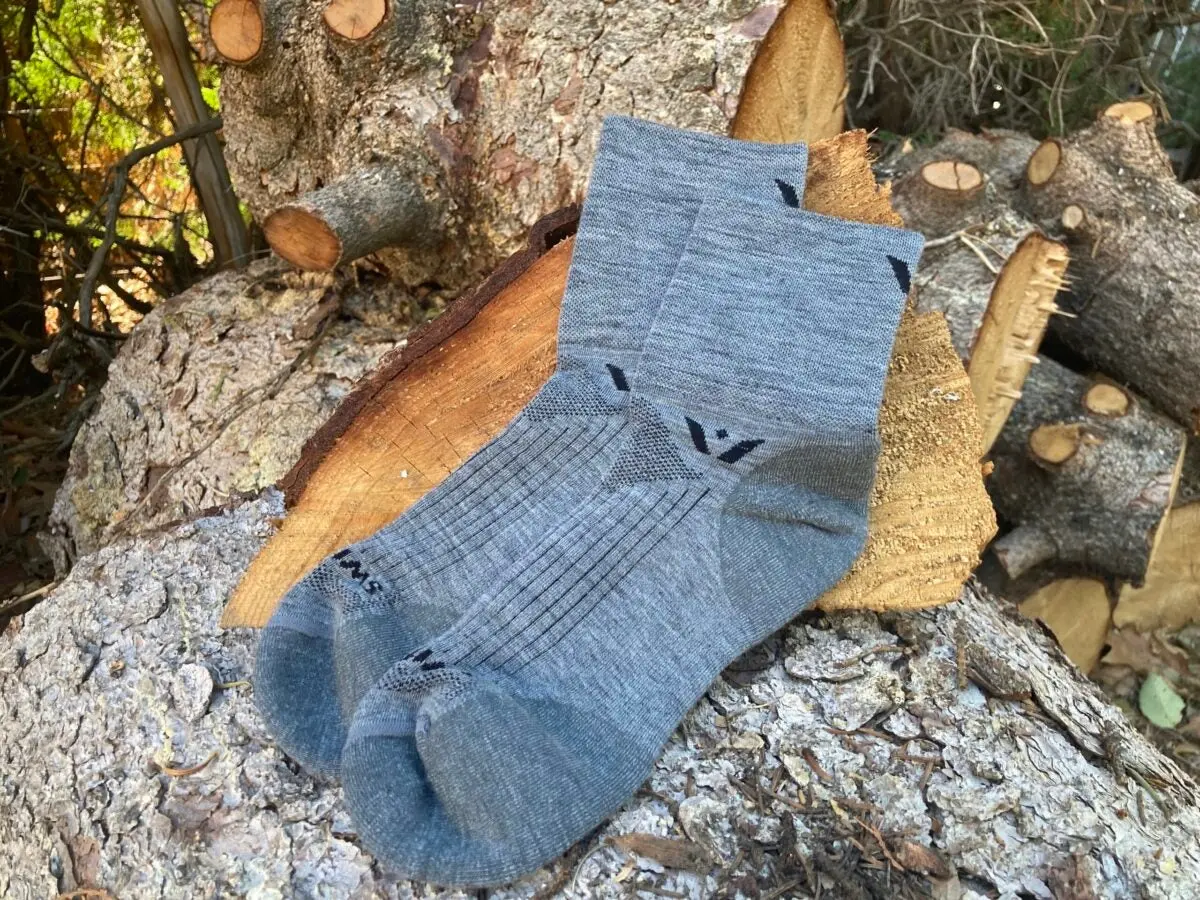
These Swiftwick socks are my favorite pair for hiking. Meg Carney
For the weight of the socks, I found them highly insulating and ideal for fluctuating temperatures in the mountains. They’re comfortable to wear during the day while hiking or at night around a campfire. The wool materials are naturally odor-resistant, help move moisture away from your feet, and increase thermal regulation. These socks are an excellent value for the price, mainly because they offer a high level of durability.
Best for Men: Smartwool Men’s Mountaineering Heavy Crew Socks
Best for Men

Specs
Length: Crew
Materials: 74% Merino Wool, 25% Nylon, 1% Elastane
Thickness: Extra Heavy Cushion
Pros
Excellent moisture management
Snug fit
Odor resistant materials
Thick cushion for comfort and warmth
Cons
Can run too tight
The Smartwool Men’s Mountaineering Extra Heavy Crew Socks utilize a 3×1 knit for a close-but-comfortable fit, making them the best warm socks for men. The extra-heavy cushioning, specific ankle and arch support, flat-knit toe, and 74% merino wool make for a truly excellent wearer experience. As should be the case for all cold-weather socks, these have superior moisture-wicking capabilities and the necessary levels of comfort and warmth. Smartwool does not specify these socks as men’s or women’s on their website, so fit can be assumed as unisex.
Best for Women: **Smartwool Women’s Hike Classic Edition Full Cushion Solid Crew Socks
**
Best for Women

Specs
Length: Crew
Materials: 56% Merino Wool, 11% Nylon, 31% Recycled Nylon, 2% Elastane
Thickness: Midweight
Pros
True to fit
Ideal insulation for winter
Easy care instructions
Cozy padding
Excellent moisture wicking
Cons
Casual, loose fit
If you are craving a sock you can wear on the trail or lounging at home, the Smartwool Women’s Hike Classic socks are a comfortable and versatile option. Made with 56% Merino wool, they maintain their warmth and odor-resistant qualities, but with the additional synthetic materials maintain more elasticity and durability. The mix of fibers also gives the wearer a soft, comfy feel with no itch. We like the fit of these socks, which are true to size. However, they tend to be looser than other hiking or wool sock options, so be aware that while snug, they may allow for more movement.
Best Wool: Danish Endurance Merino Wool Socks
Best Wool

Specs
Length: Crew
Materials: 30% Wool, 36% Nylon, 33% Acrylic, 1% Elastane
Thickness: Midweight
Pros
Affordable price
Durable materials
Versatile wear
Great customer service
Cons
Ankle materials should be tighter to avoid bunching
With all of the essentials of merino wool socks, the Danish Endurance Merino wool socks provide the softness, warmth, and moisture-wicking necessary for a cold-weather sock. On top of that, they have ventilation for added moisture removal. They are cushioned and tailored specifically to prevent chafing, irritation, and blisters from extended hiking or while working in boots. With all of those features, they manage to be a reasonably lightweight material that’s comfortable for all-day wear.
Best Cabin: Tibetan Socks Hand-Knit Wool Fleece-Lined Long Slipper Socks
Best Cabin

Specs
Length: Knee High
Materials: 100% wool shell and fleece lining
Thickness: Extra cushion
Pros
Handmade
Slip-resistant sole
Fun designs
Thick, slipper-like design
Cons
Not the most durable
Style gets to match substance with cabin socks, but with these fleece slipper socks, you don’t have to sacrifice: These offer hand-knit-in-the-Himalayas New Zealand–wool exterior and super cozy fleece interior—with non-skid bottoms, to boot. Five unisex sizes of these comfy socks allow for a precise fit, and the sturdiness of their construction means they won’t droop but also won’t constrict. The challenge here will be leaving the cabin, as it were.
Best Budget: Columbia Medium Weight Thermal
Best Budget
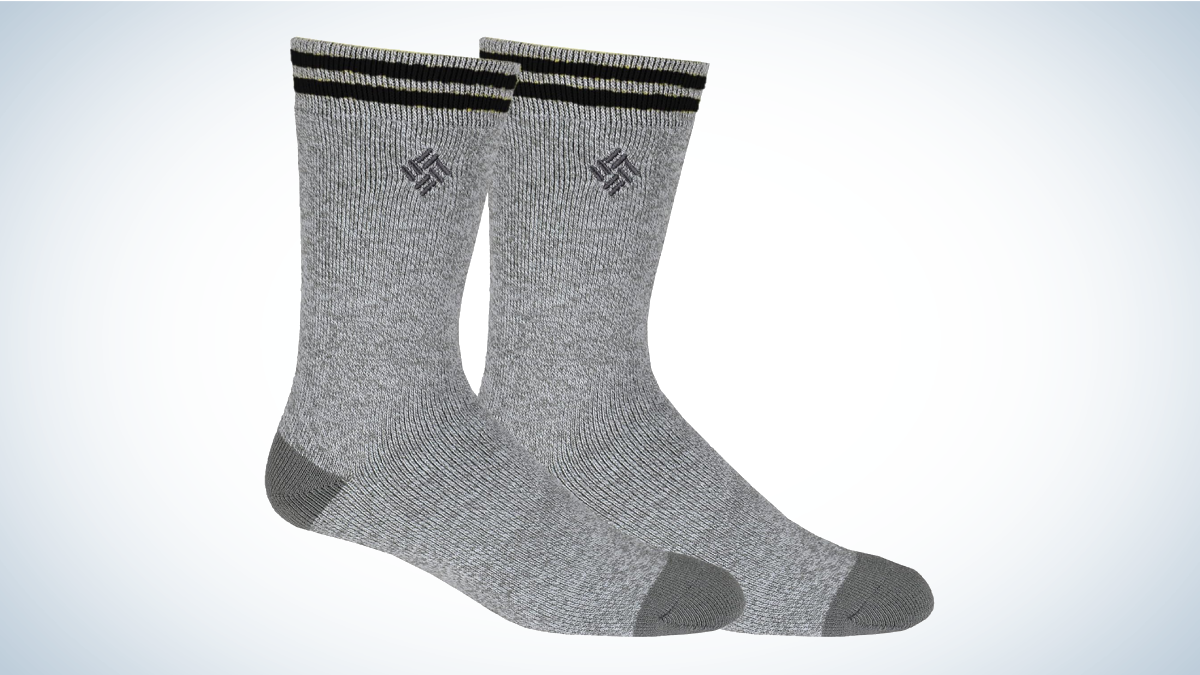
Specs
Length: Crew
Materials: 90% Acrylic, 8% Polyester, 1% Spandex, 1% Other Fibers
Thickness: Midweight
Pros
Affordable price
Decently comfortable
Easy care and washing
Warm for the weight and materials
Cons
Not the most durable option
Made from fully synthetic materials
If you’re on a budget but want a pair of warm socks for hiking, the Columbia Thermal socks are an excellent midweight option. They’re about half the price of most other hiking sock options of the same thickness, but as a budget pick, you are compromising some aspects of performance. While they offer decent warmth and comfort level, they tend to lack durability and general performance. Since they’re made from synthetic materials, they don’t have the same temperature-regulating and odor-resistant properties as wool.
Honestly, these socks are a good fit for short hikes or just lounging around outside. If you’re doing more intense outdoor activities or want a durable pair of socks for work, these likely won’t cut it.
What to Consider When Choosing Warm Socks
From the top, let’s debunk some common questions and myths when it comes to choosing socks for cold weather. Like: Are two layers of socks better than one? (No, with the exception of quality liner socks designed for the job. In all cases, it’s mostly about sock and footwear fit, in addition to material.) Are cotton socks good for cold weather? (Also no. Cotton holds moisture and will cause chill.) With that in mind, consider your primary use, climate, and duration outdoors—and we’ll help guide you to your best warm socks for this winter.
Material and Sizing
The best winter socks overall are made from a merino wool blend so they are soft , warm, and moisture-wicking. They should be fitted enough that they’ll stay close to your skin, not bunch up under your boots (those air pockets invite in cold, as does adjusting your socks, besides being a nuisance), and not make your boots too snug (a too-tight fit will inhibit blood flow, and therefore warmth). At the same time, you don’t want your socks to be too tight, for comfort and circulation.
Many sock designs are unisex, and if you’re attentive with sizing—and, FYI, numerical sock sizes are not shoe sizes, they’re the measurement of your foot in inches—there’s no reason to limit yourself to pairs labeled either men’s or women’s. Remember that the sizing piece matters, though, as fit is an essential piece of sock performance, so if they are labeled one way or the other, check the numbers on both, particularly if you need a wider calf (men’s socks tend to have a looser top opening) or a taller or shorter tube (varies by sock).
Moisture-Wicking Capabilities
Both of our picks for overall best warm socks are made from merino wool, and that’s no accident. Merino wool socks are excellent for moisture-wicking, and if you’ve been stuck in a tree stand or on the trails in bad weather, you know that moisture is a quick path to freezing cold. The wool keeps skin from becoming (or staying) clammy or sweaty, which then stops that chill factor. Cotton, on the other hand, pulls moisture from your skin but holds onto it, trapping it in rather than wicking it away. And the thickest socks in the world won’t keep you warm if water gets in.
Merino is also an efficient insulator, and you can get more warmth with less thickness than with most other sock materials. Likewise—and not frivolously for a layer that’s going to be against your skin all day—merino wool is soft, particularly when you buy from a reputable brand that’s sourcing quality wool.
Weather
If your setting is such that keeping body warmth in and external cold out will not suffice, you may be in the market for heated socks. Designed for extremely cold weather—and often most necessary when you’re not actively moving, and therefore not generating additional blood flow or body heat—most heated socks have a small, rechargeable lithium-ion battery pack at the top of each sock tube, with heating elements woven into the socks.
This is where pairs diverge: voltage/power, and the quantity and placement of the heat-source layer. Your best best will be heating that wraps the foot, rather than just being on the top or bottom. As far as power, opt for sufficient strength for the climate you’ll be in. Duration of power depends on heat level (e.g., will last longer on low heat than high), but our advice: Buy, and carry with you, extra batteries. It’s a small additional investment—and they’re rechargable—to make sure your heated socks keep heating as long as you need them to.
Want thick warm socks without wearing electric wiring? Try quality thermal socks, instead.
Activity
A good pair of warm, winter hiking socks demands all the features of warm winter socks at large, but with activity-specific considerations, too. Particularly: How the sock fits the foot.
With hiking socks, you’re looking for fit at least as much as warmth for a couple reasons. One, you’re going to be moving, so your blood is going to be flowing and you’ll be generating body heat (and sweat, so don’t skimp on moisture-wicking, adding a thin liner sock for that purpose if you tend to run sweaty). Second, loose, ill-fitting socks with too much bulk make boot conditions ripe for blisters, and too-tight socks will restrict blood flow, and therefore warmth and comfort.
Look for thoughtfully designed seaming—especially in the toe and heel, as bulky or thick seams will quickly become irritating with movement—as well as support through the arch and ankle, as those muscles, fascia, and tendons are under a lot of strain while hiking.
Think, too, about your specific boots. You don’t want too much compression, and you do want the sock to protect you from chafing at the top of the boots.
At some point, you’re coming inside, and your feet are not going to magically transport to someplace where it’s not winter. Both as a transition from outdoors-in or a 24-hour sort of indoor footwear, cabin socks (a.k.a., slipper socks) do the trick.
You want comfort, above all else; the “slipper” part of the title is there for a reason. This will mean a looser fit with flexibility in the ankle and footbed, but not so loose they’re falling down your legs. And while you still want moisture-wicking, since you’ll be sheltered from the elements, priority here on the materials goes toward comfort. That is: warm, super thick socks you both won’t want to take off, and are so comfortable you’ll forget they’re on—with some grip on the soles to keep you steady on hardwood and tile floors. There’s no better choice when it comes to comfy socks than this pick.
Price
The good news about the ubiquitous need for warm winter socks is that quality pairs can be found at affordable prices. The complicating factor: To get that great price, you’ll generally be buying a pack of several pairs. The still very okay news: You’ll use them, and have back-ups when you’re behind on laundry, lose one, or a pair gets wet out in the field.
Beware, though, before scrounging to the bottom of the price barrel: Quality materials don’t come free, even if you can find them affordably. Check the material list (we’d look for a merino wool blend), the fit, and that the socks have a reinforced toe and heel.
FAQs
Q: What type of socks keep feet warmest?
The most important factors looking at what type of socks keep feet warmest are fit (snug, not tight; thick, not bulky) and material (moisture-wicking, e.g., merino wool is non-negotiable.) From there, consider activity: hiking socks vs. heated socks vs. cabin socks, for example.
Q: Who makes the best warm socks?
Who makes the best warm socks depends on your specific needs, the best brand of winter socks must have a long, positive track record making comfortable, durable winter socks a variety of fits and functions, as reliable customer service. In general, we’re confident saying that you’re in very good hands (er, feet) with Smartwool socks.
Q: Are merino wool socks good for cold weather?
Yes. Merino wool socks are good for cold weather because merino wool is a highly efficient moisture-wicking material, keeping feet warm and dry in winter conditions. Also, wool keeps you warm even when it’s wet. Merino wool is soft, and doesn’t itch. and tends to offer a good, flexible fit.
Best Warm Socks: Final Thoughts
Best Overall: Duckworth Midweight Hiking Crew Socks
Best for Hunting: Darn Tough Hunting Boot Socks
Best for Men: Smartwool Men’s Mountaineering Crew Socks
Best for Women: Smartwool Women’s Hike Classic Edition Full Cushion Solid Crew Socks
Best Wool: Danish Endurance Merino Wool Socks
Best for Hiking: Swiftwick Pursuit
Best Cabin: Tibetan Socks Hand-Knit Wool Fleece-Lined Long Slipper Socks
Best Budget: Columbia Medium Weight Thermal
When it comes to the best warm socks, the key is fit (snug but not tight), material (moisture wicking, and merino wool when it’s an option), and construction (particularly with seaming) for comfort and durability.
Once you buy, keep your super warm socks in super good shape by heeding the manufacturer’s guidance for laundering, which often means inside out, with a wool-friendly cycle and detergent, and air-drying.
Why Trust Us
For more than 125 years, Field & Stream has been providing readers with honest and authentic coverage of outdoor gear. Our writers and editors eat, sleep, and breathe the outdoors, and that passion comes through in our product reviews. You can count on F&S to keep you up to date on the best new gear. And when we write about a product—whether it’s a bass lure or a backpack—we cover the good and the bad, so you know exactly what to expect before you decide to make a purchase.
![Field & Stream [dev]](https://images.ctfassets.net/fbkgl98xrr9f/1GnddAVcyeew2hQvUmrFpw/e4ca91baa53a1ecd66f76b1ef472932b/mob-logo.svg)





